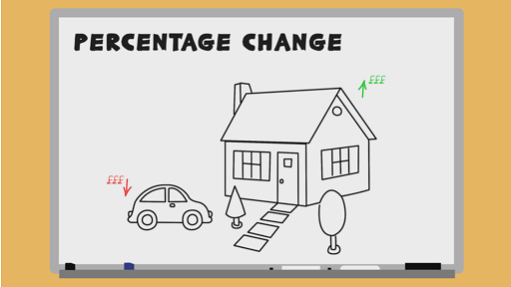8.3 Percentage change
Watch the video below on how to calculate percentage change, then complete Activity 20.

Transcript
You will already be familiar with the concept that if you buy a new car, when you come to sell it, its value is likely to have decreased. On the other hand, if you're lucky, when you buy a house and then wish to sell, you may be able to sell it for more than you bought it for.
The percentage difference between the original price and the sale price is called percentage change. This can be useful for working out the percentage profit, or loss, or finding out by what percentage an item has changed in value. It's important to recognise that percentage change can be either positive, if the price has increased, or negative, if the value of the item has gone down.
To calculate the percentage change, we need to use the simple formula: percentage change equals the difference, divided by the original, multiplied by 100. 'Difference' refers to the difference between the two values. That is, the cost before and after. 'Original' means the original value of the item.
Let's use this formula in an example. A train ticket used to cost £24. The price has gone up to £27.60. How do we find the percentage increase? First, you need to find the difference in cost. The difference = £27.60 - £24, which is £3.60.
Next, divide this difference by the original cost, and then multiply by 100. £3.60 divided by £24, x 100, = 15. The cost of the train ticket has increased by 15%.
Now try another example. You bought a car for £4,500 and you managed to sell it for £3,200. What is the percentage decrease? You should give your answer to two decimal places. The difference is £4,500 - £3,200, which = £1,300. Divide this by the original cost of £4,500. 1,300 divided by 4,500, x 100, equals a 28.89% per cent decrease. Now practise using the percentage change formula in the next activity.
Activity 20: Percentage change formula
Practise using the percentage change formula which you learned about in the video above on the four questions below. Where rounding is required, give your answer to two decimal places.
Last year your season ticket for the train cost £1300. This year the cost has risen to £1450. What is the percentage increase?
Answer
Difference: £1450 − £1300 = £150
Original: £1300
Percentage change = × 100
Percentage change = 0.11538... × 100 = 11.54% increase (rounded to two d.p.)
You bought your house 10 years ago for £155 000. You are able to sell your house for £180 000. What is the percentage increase the house has made?
Answer
Difference: £180 000 − £155 000 = £25 000
Original: £155 000
Percentage change = × 100
Percentage change = 0.16129... × 100 = 16.13% increase (rounded to two d.p.)
You purchased your car 3 years ago for £4200. You sell it to a buyer for £3600. What is the percentage decrease of the car?
Answer
Difference: £4200 − £3600 = £600
Original: £4200
Percentage change = × 100
Percentage change = 0.14285... × 100 = 14.29% decrease (rounded to two d.p.)
Stuart buys a new car for £24 650. He sells it 1 year later for £20 000. What is the percentage loss?
Answer
Difference: £24 650 − £20 000 = £4650
Original: £24 650
Percentage change = × 100
4650 ÷ 24 650 × 100 = 18.86% loss (rounded to two d.p.)
Congratulations, you now know everything you need to know about percentages! As you have seen, percentages come up frequently in many different areas of life and having completed this section, you now have the skills to deal with all kinds of situations that involve them.
You saw at the beginning of the section that percentages are really just fractions. Decimals are also closely linked to both fractions and percentages. In the next section you will see just how closely related these three concepts are and also learn how to convert between each of them.
Summary
In this section you have:
found percentages of amounts
calculated percentage increase and decrease
calculated percentage change using a formula
expressed one number as a percentage of another.
